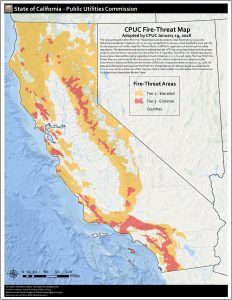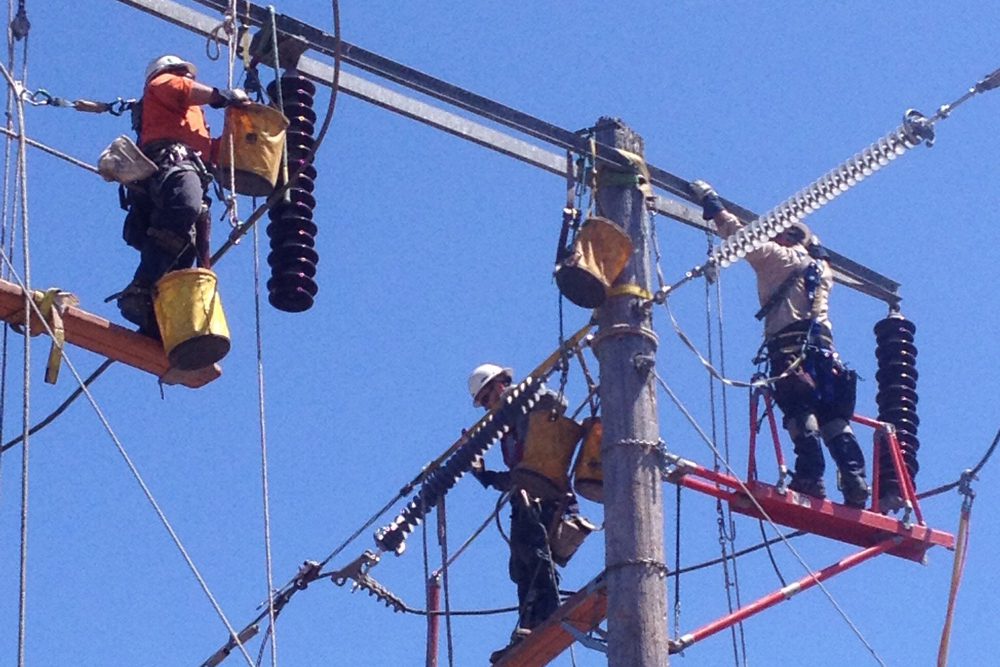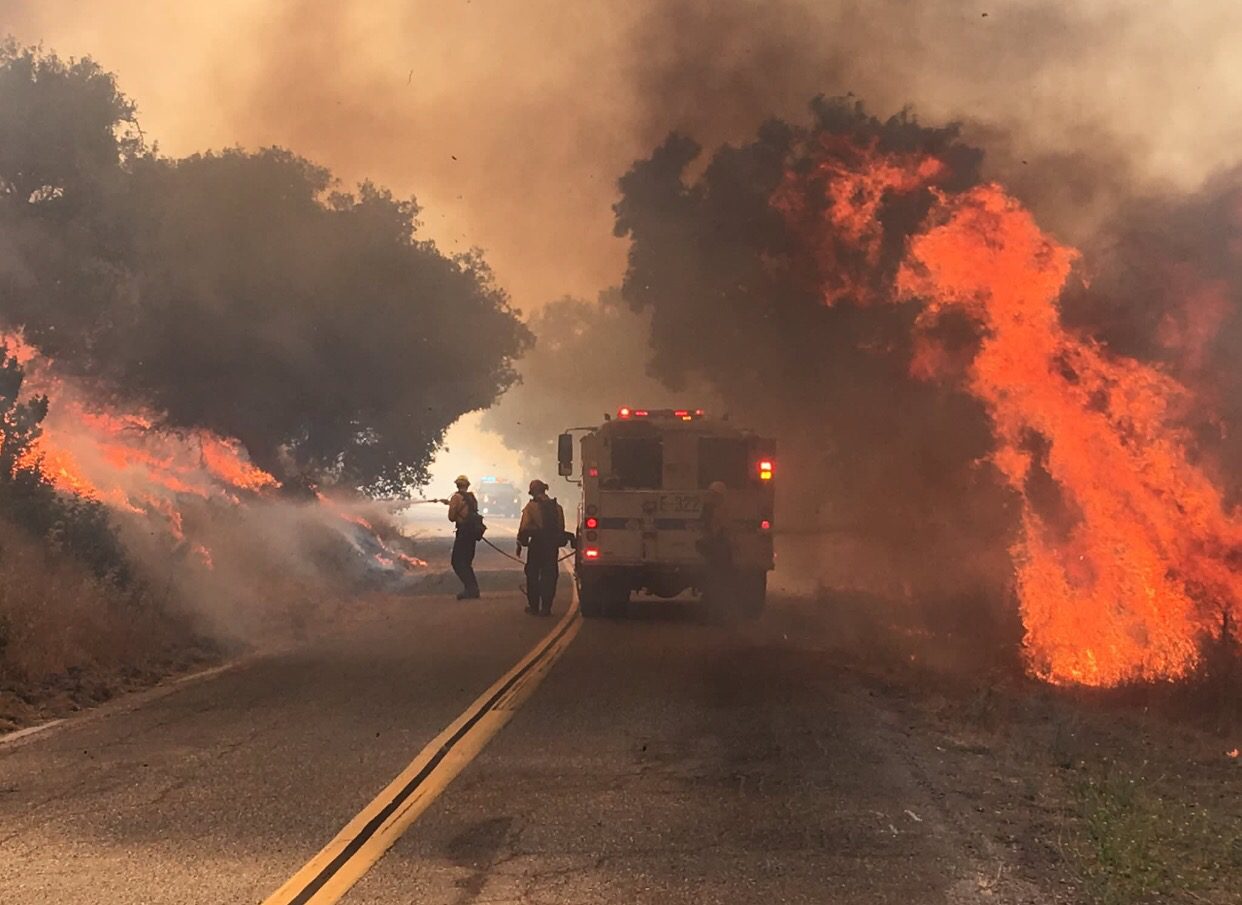By Janene Scully
Noozhawk North County Editor
Santa Barbara County residents should prepare to be without electricity amid what one utility company dubbed “the new abnormal” as representatives spread the word about programs aimed at reducing fire danger by preemptively shutting off electrical power.
While efforts have focused on rural areas that are deemed most at risk from equipment sparking a deadly and destructive blaze like the Thomas Fire or Camp Fire, the preemptive power outages could be felt in local communities, according to Eric Daniels, a Pacific Gas & Electric Co. representative.
During a recent Solvang City Council meeting, Daniels provided a presentation about the PG&E Public Safety Power Shutoff Program and efforts that will make the equipment more resilient in the future and reduce the risk of an emergency outage.
In short, he said, residents, businesses and government agencies need to be prepared.

The high fire-threat areas have been identified in California with yellow representing Tier 2 or elevated and Tier 3, in red, for extreme. Enhanced fire safety efforts will focus on these areas.
“Homes and businesses should have emergency plans,” Daniels said. “Think about if there are sustained outages of power, what is it you are going to do?”
Residents should consider getting generators or backup options for refrigerators, air conditioners or vital medical equipment in case of extended outages.
Both PG&E, which serves the Santa Ynez Valley and communities to the north, and Southern California Edison, which serves Goleta and areas to the south, developed the Wildfire Safety Programs and notification plan with the California Public Utilities Commission.
Cal Fire has created maps designating high fire-threat areas with some sections deemed Tier 2, or elevated, and shown in yellow on maps, while other areas are labeled Tier 3, or extreme, and shown in red.
A number of factors — such as a red flag warning about expected hot temperatures, low humidity, dry vegetation, gusty winds and real-time observations — will lead to a decision of when to implement a Public Safety Power Shutoff (PSPS).
“Not any one of them is sufficient enough to impose a PSPS,” Daniels said. “You’re going to have to have a combination of them.”
For a distribution line sitting in an area deemed vulnerable to fire, a shutoff would affect only those served by the circuit.
“But if it happens to be a transmission line, it could impact a great number of folks downstream from that location,” he said. “Because transmission lines are like freeways, they bring the greater volume of energy to communities, and distribution lines are like city streets. They are taking it out into neighborhoods.”
The grid carrying electricity to Solvang and Buellton goes through high-fire-threat areas, leaving the communities vulnerable to a PSPS.
Power company representatives hope to begin warning residents about a pending PSPS about 48 hours in advance, communicating to customers, government leaders, hospitals and more about a planned outage. Restoration after a PSPS could take time since the weather danger must pass and electricity must be restored in phases, he added.
In another fire preventive measure, PG&E plans to temporarily disable an automatic system that attempts to re-energize a line but actually could create a potential fire hazard if a tree branch or foreign object fell on the equipment.
“In the summer and in the fire season, they’re dangerous because every time you’re trying to pass energy back through that foreign object on the line, you could create a spark which could create a fire hazard, so we’re going to disengage them,” Daniels said. “The moral of this little tale is that we want the public and you to understand that in the summertime, when we disengage this automation, the outages will be longer in duration.”
A crew member must inspect the line to ensure that it’s clear and manually re-engage it before power will be restored, he said, adding that the length of the outage depends on weather conditions.
The proactive power shutoff is just one step undertaken by utility companies to guard against dangerous wildfires. A revised vegetation management program includes efforts to reduce fire risk around electrical equipment with areas below and above power equipment now cleared. Instead of an 18-inch clearance swath around a conductor, or wire, the new efforts will aim at establishing a 4-foot area around power lines.
“That is throughout the grid, throughout the system,” Daniels told the Solvang council. “It doesn’t matter if it’s a high-fire-threat area or not, that’s what we’re doing even here in town.”
By 2022, PG&E plans to install 1,300 new weather stations and 600 new surveillance cameras in high-fire-threat areas to help forecasters assess conditions. PG&E has enhanced its inspection system, using crews, helicopters and drones to assess equipment in need of fixes and has located more than 50,000 repair tags across its service territory, Daniels said.
Long-term goals call for replacing wooden poles with metal versions in high-fire-threat areas to make them more resistant to fire and to install insulated wiring to make them less susceptible to shorting, which leads to dangerous conditions.
The changes will make the firm’s electrical system “much more robust,” Daniels said. “These things will help to reduce the risk of the PSPS affecting your community in the long term.”
Resident Kaaren Jordan expressed concern about people who can’t afford generators, calling for the creation of a pet-friendly cooling center in the Santa Ynez Valley. She said her research identified the Santa Ynez Valley Union High School as a potential site with air conditioning to accommodate residents during the outage.
“If PG&E can provide a generator like they did for Yuba City three weeks ago, we would be fine,” she said, referring to a recent PSPS. “It would be absolutely great.”
For more information about the SCE Public Safety Power Shutoff visit www.sce.com/safety/wildfire.
For more information about PG&E’s Public Safety Power Shutoff visit https://www.pge.com/en_US/safety/emergency-preparedness/natural-disaster/wildfires/wildfire-safety.page.
To ensure the power company has ways to notify you about a pending alert, visit www.pge.com/mywildfirealerts.
In anticipation of the new program, PG&E’s website for power outages has a new category to show Public Safety Power Shutoffs.
As part of the PSPS outreach effort, utility representatives have urged customers to confirm their contact information on their PG&E or SCE accounts so notices can be delivered by phone, text and email.
— Noozhawk North County editor Janene Scully can be reached at jscully@noozhawk.com.








